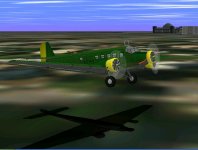Spanish CASA 352-L trial version
Hello Smilo, Hello Ivan, Hello All!
I hope everyone has recovered from the corresponding Christmas and New Year indulgance!
To start the New Year, here is a TTV - a textured trial version of the CASA 352-L (Ju-52),
one of 170 units bult in Spain between 1942 and 1954 under licence from Junkers.
The model is very similar to the trial German JU-52/3m one I posted a while ago, with the
difference that this one is an unarmed transport and paratrooper aircraft. The engine
cowlings also have different shapes, and have air-intake scoops on top. Also, engines
have no toe-out like on the German Ju-52.
Power is 3x775 Hp ENMA Beta B4 radials (Licence built BMW-132). S.L. max speed is 175 mph.
Instead of armament, there are 18 paratroopers acounted for in the .air file, and nothing
in the Dp file, and weight is almost 2200 lb under MTOW, which should be fine.
Propellers are Ivan´s 2-pitch,(20 and 30 degrees), 2-blade Hamilton Standard, with the curves
in the propeller tables tweaked for the speed range this aircraft operates at. It is quite curious
to watch them operating with the Beckwith Test Gauge.
The model itself has a parts count of 146.3%, despite not having a transparent cockpit.
A virtual cabin via SCASM is however planned.
One interesting thing I noticed as regards the use of left/right Wing/Nose templates, is that
they work infinetely better if they aligned with the portion of the engine that is in left/right
nose sections, (in this case the rear edge of the cowling), rather than with the swept back
leading edges. There is no momentary bleed of the engine bulkhead.
The manually made textures try to emmulate grey corrugated aluminium, light blue underneath,
with painted military numbers and emblems. Those took a long time to make. I suppose if I knew
how to use more sophisticated paint programmes, it would help!
Mostly, the flight simulator light-blue is still too strong for colouring under-surface textures of
aircraft, but looking at photos of the CASA 352L, in this case, FS light blue it fits very nicely.
I suppose the reason is that the sky in Spain is a clearer light blue than elsewhere, where
undersurfaces have to be painted in a much paler blue or even grey, the colour of more
cloudy skies.
For the moment, the exhausts are not textured, but rust-coloured. I always find it difficult to
decide how to colour exhausts - in pictures, it ranges from bright chrome to flaked burnt paint
of different greys, browns and blacks, or not-so-bright rust. Anyway, there are textures still free
to do something about it if anyone has a suggestion better than bright orange rust!
Then, another fun aspect while building was the glue sequencing: With the number of items put
together with propellers and engines in the nose and nacelle sections, glue sequences had to be
quite intricate to be effective to keep bleeds to a minimum.
Anyway, here is the model and its AFX as a test version, should anyone be interested in taking a look.
Incidentally, better late than never, I noticed yet another glitch in the 3-view drawings I was using
- they didn´t show the hump in the fuselage back a few feet behind the cockpit - they had the back completely straight! Needless to say,I corrected it as soon as I noticed, also on the other version.
Ivan had already pointed out that although the plans seemed quite detailed, they did contain a few mistaken shapes...
I hope you like the test model! As always, suggestions and complaints will be much appreciated and
happily attended to!
Cheers,
Aleatorylamp










